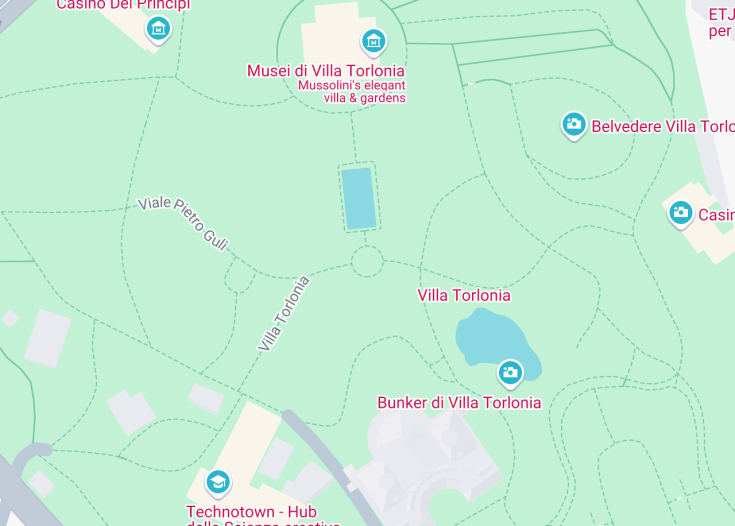The Obelisks of Villa Torlonia stand as striking testaments to the grandeur of Roman architectural heritage. Commissioned by Prince Alessandro Torlonia in the mid-19th century, these granite obelisks serve as memorials to his parents and reflect the opulence and cultural significance of their era.
Visitors are encouraged to arrive early in the day to enjoy the tranquility of the gardens surrounding the Villa Torlonia obelisks. Early mornings offer a serene atmosphere, allowing for uninterrupted photography and reflection.
For a more enriching experience, consider joining a guided tour that explores the Villa Torlonia grounds. These tours often provide insightful historical context about the obelisks and the Torlonia family’s influence on Rome’s cultural landscape.
The Majestic Obelisks of Villa Torlonia: A Journey Through History
The Obelisks of Villa Torlonia in Rome, Italy, are magnificent monuments that captivate tourists with their historical and architectural significance. Commissioned by Prince Alessandro Torlonia in the 19th century, these two stunning granite obelisks stand at an impressive height of 10.2 meters (33 feet) each. Erected in 1842, these monolithic structures serve as a tribute to the prince’s parents, celebrating familial love and legacy.
Visitors are often drawn to the intricate Egyptian hieroglyphs that adorn each obelisk, which convey dedications that add a layer of mystery and fascination. The first obelisk, set up before a grand crowd including notable figures like Pope Gregory XVI and King Ludwig I of Bavaria, symbolizes the blend of history and culture that is characteristic of Rome. As you explore the villa grounds, these towering monuments not only narrate stories from the past but also provide a picturesque backdrop for memorable photographs.
Explore the Enchanting Grounds of Villa Torlonia
At the Villa Torlonia, visitors can indulge in a variety of engaging activities and attractions beyond just admiring the obelisks. The villa is surrounded by beautifully landscaped gardens, perfect for leisurely strolls and picnics.
Discover Architectural Wonders
Aside from the obelisks, the villa itself boasts remarkable architecture, featuring the eclectic styles that reflect different historical periods. You can also explore charming buildings like the Casina delle Civette, showcasing Art Nouveau designs.
Enjoy Cultural Events
Throughout the year, Villa Torlonia hosts cultural events, exhibitions, and concerts, allowing visitors to immerse themselves in the vibrant atmosphere of Roman culture.
Interesting Facts About the Obelisks of Villa Torlonia
A fascinating aspect of the Obelisks of Villa Torlonia is their connection to ancient history. The hieroglyphs are dedicated not simply to the Torlonia family but also reflect the grandeur of ancient Egyptian civilization. This blend of cultures is a remarkable feature that highlights the significance of arts and family legacies across different eras. Moreover, these obelisks were erected with much fanfare, making it a grand event that attracted attention from various dignitaries at the time, further emphasizing their importance in both local history and tourism today.
Discover the Majestic Obelisks of Villa Torlonia in Rome, Italy
The Obelisks of Villa Torlonia stand as magnificent testaments to architectural grandeur and historical significance. Commissioned by Prince Alessandro Torlonia in the 19th century, these impressive granite obelisks pay homage to his parents and embody the timeless allure of ancient Egypt. Each obelisk stands at an impressive height of 10.2 meters (33 feet) and features inscriptions in both Egyptian hieroglyphs and Latin, providing a glimpse into the rich cultural tapestry of the past.
Your visit to the Obelisks is ideal for history buffs, art lovers, and families alike. Expect an experience steeped in both history and beauty, with opportunities for stunning photographs set against the backdrop of the villa’s picturesque gardens. The obelisks are perfectly integrated into a broader tourist route, allowing you to enjoy the surrounding attractions, such as the stunning architecture and manicured landscapes of Villa Torlonia itself.
When visiting the obelisks, don’t miss the chance to explore the various paths and tranquil spots within the villa’s grounds. A leisurely stroll here allows for reflection and appreciation of the site’s beauty. For those seeking insights that only a professional guide might provide, consider joining a guided tour that delves into the fascinating history and significance of the obelisks and their creator, Prince Alessandro Torlonia.
Moreover, the villa hosts seasonal events and exhibitions, making each visit uniquely captivating. With its serene ambiance, the Obelisks of Villa Torlonia are a must-see, offering a glimpse into Rome’s storied past amidst a tranquil setting.
When is the Best Time to Visit the Obelisks of Villa Torlonia in Rome, Italy?
For an unforgettable experience at the Obelisks of Villa Torlonia, consider visiting during the spring or fall months. These seasons feature mild weather, making it ideal for exploring the outdoor spaces of the villa.
Recurring Event
One of the best opportunities to visit occurs during the Villa Torlonia Art Festival, held annually from May to September. This event includes art installations and performances set against the stunning backdrop of the obelisks, attracting both locals and tourists who enjoy experiencing culture in a picturesque setting.
Accessibility and Limitations
The Obelisks of Villa Torlonia welcome visitors; however, accessibility may present challenges for some. The paths are generally well-maintained, but terrain can be uneven in certain areas.
Accessibility
Limitations
- Access to certain areas may be restricted during special events.
- Large groups may require prior arrangement for guided tours.
- Food and drink are not permitted in designated historical areas.
Notes to Visitors
- Photography is encouraged, but please respect other visitors’ personal space.
- Visit early in the morning or late in the afternoon for a more peaceful experience.
- Pet access may be limited; check ahead if you plan to bring your pet.
General Information
Details for your visit to the Obelisks of Villa Torlonia
Location
The Obelisks of Villa Torlonia is conveniently located near other notable landmarks, making it an easy addition to your Roman itinerary. Public transportation options are available, enhancing accessibility from various parts of the city.
Address:
Villa Torlonia, 00161 Roma RM, ItalyVisiting Information
Visitors can enjoy the Obelisks of Villa Torlonia at their convenience, as the site is generally open to the public without strict closing times. However, the best time to visit is during the early morning or late afternoon, when the light is perfect for photographs and the grounds are less crowded.
How to Reach the Obelisks of Villa Torlonia
Reaching the obelisks from the city center is straightforward, with various transportation options available:
Car
The Obelisks of Villa Torlonia can be easily accessed by car, with parking facilities located nearby for a nominal fee.
| Route | Distance | Travel Time |
|---|---|---|
| From Termini Station | 3 kilometers (1.9 miles) | 10 minutes |
| From Vatican City | 6 kilometers (3.7 miles) | 15 minutes |
| From Colosseum | 4 kilometers (2.5 miles) | 12 minutes |
Public Transport
Alternatively, public transportation is readily available, with several bus and metro lines serving the area.
| Public Transport Option | Distance | Travel Time |
|---|---|---|
| Metro (Line B to Bologna Station) | 1 kilometer (0.6 miles) | 10 minutes on foot |
| Bus 63 (from Termini Station) | 3 kilometers (1.9 miles) | 15 minutes |
Nearby Attractions
- Villa Torlonia – 0 meters (0 miles)
- Servian Wall – 1.2 kilometers (0.75 miles)
- Catacombs of Priscilla – 1.6 kilometers (1 mile)
- Borghese Gallery – 1.9 kilometers (1.2 miles)
- Pincian Hill – 2.1 kilometers (1.3 miles)
- Flaminio Obelisk – 2.3 kilometers (1.4 miles)
- Santa Maria della Vittoria – 2.4 kilometers (1.5 miles)
- Termini Station – 3 kilometers (1.9 miles)
- Trajan’s Market – 3.5 kilometers (2.2 miles)
- Colosseum – 4 kilometers (2.5 miles)
- Vatican City – 6 kilometers (3.7 miles)
- Pantheon – 3.7 kilometers (2.3 miles)
Common Questions
What are the historical significance and origins of the obelisks at Villa Torlonia?
The obelisks at Villa Torlonia are significant artifacts that reflect the cultural and political aspirations of the Torlonia family during the 19th century. Commissioned by Prince Alessandro Torlonia in memory of his parents, the two granite obelisks were erected between June and July of 1842.
These obelisks, standing at 10.2 meters (33 feet) tall, are not merely decorative features; they embody the grandeur of classical antiquity and the fascination for Egypt that was prevalent among European aristocracy, particularly during the Romantic period. They were crafted with inscriptions in Egyptian hieroglyphs, emphasizing their ancient roots, and these are complemented with Latin translations, making them accessible for a wider audience.
The celebrated event for the first obelisk’s dedication, attended by dignitaries including Pope Gregory XVI and King Ludwig I of Bavaria, highlights the importance of these monuments in terms of social status and political power. They serve as a testament to the merging of art, history, and personal legacy, providing visitors with a glimpse into the era’s aesthetic sensibilities and the influence of the Egyptian revival in Europe.
What do the inscriptions on the obelisks at Villa Torlonia say?
The inscriptions on the obelisks at Villa Torlonia are composed primarily of Egyptian hieroglyphs, which uniquely honor the family heritage of the Torlonia lineage. Each scholarly elaborate inscription conveys dedications and reverences to the respective parents of Prince Alessandro Torlonia, ensuring that their memories endure through time.
Alongside the hieroglyphics, Latin translations are provided on the obelisk pedestals, allowing a broader audience to grasp the meanings behind the ancient symbols. These inscriptions enhance the cultural context of the obelisks, showing how the Torlonia family sought to link their legacy to the grandeur of ancient civilizations.
Visitors fascinated by epigraphy and ancient languages will find the inscriptions not only historically significant but also artistically compelling, highlighting the integration of art and language through the ages. Understanding these written records enriches the experience and deepens appreciation for these monumental structures.
Are there any legends or myths associated with the Villa Torlonia obelisks?
While the obelisks at Villa Torlonia do not carry famous myths akin to other ancient structures, they are woven into the narrative of the Torlonia family and the overarching fascination with ancient Egypt during the 19th century. The installation of the obelisks signified the family’s aspirations for social prestige and cultural enlightenment.
In broader terms, the allure of obelisks is often steeped in mystique, as they are symbols of strength, continuity, and the afterlife, long linked to the Egyptian civilization. It is said that the presence of these great stone structures attracts stories and legends, particularly related to ancient deities and the afterlife, fostering an air of myth around them.
The grandeur of the ceremonies surrounding their erection, attended by prominent figures like Pope Gregory XVI, adds a layer of legend to their history. While not heavily documented, the obelisks serve as cultural symbols representing the interplay between individual legacy and historical significance, inviting visitors to contemplate the depth of their history.
What architectural styles are represented in the obelisks and their surrounding structures?
The obelisks in Villa Torlonia represent a stunning fusion of architectural styles, drawing primarily from ancient Egyptian influences, where colossal stone structures were meticulously carved and raised to honor pharaohs and gods. This architectural phenomenon reflects the trend of Egyptomania that swept across Europe in the 19th century.
Beyond the obelisks, the Villa Torlonia complex itself showcases Neoclassical and Romantic styles, characterized by symmetry, grandeur, and the use of classical elements. The juxtaposition of the ancient obelisks with the ornate designs of the surrounding villa enhances the artistic value of the site.
The meticulously landscaped gardens and the overall design of the villa incorporate elements reminiscent of the past while embracing contemporary ideas of the time, creating a rich architectural tapestry. Thus, visitors can appreciate not only the obelisks but also how they complement the greater narrative of architectural evolution and style throughout history.
What are some notable features of the Villa Torlonia complex apart from the obelisks?
The Villa Torlonia complex is rich in architectural and historical features beyond the iconic obelisks. One of the standout structures is the Casino Nobile, which exemplifies Neoclassical architecture with elegant interiors and frescoes, highlighting the artistic aspirations of the Torlonia family.
Additionally, the complex features beautifully landscaped gardens, a greenhouse, and various smaller buildings, such as the Cottage and the Temple of Saturn, which echo themes from the ancient world and offer tranquil spots for exploration.
Unique decorative elements, such as water features and sculptures, complement the overall aesthetic, making the entire site a serene retreat amidst the bustle of Rome. The harmonious blend of nature and architecture invites visitors to immerse themselves in the beauty of the landscape while reflecting on the historical significance of the estate.
As a result, Villa Torlonia provides an enriching experience for anyone interested in architecture, history, or simply enjoying lush surroundings, enhancing its appeal as a multifaceted cultural site.

Are the Obelisks of Villa Torlonia in Rome worth visiting?
The obelisks of Villa Torlonia certainly have their charm and historical significance. Standing at a height of 10.2 metres (33 feet), these granite monuments were commissioned by Prince Alessandro Torlonia in memory of his parents. The first obelisk dedicated to his father, Prince Giovanni Torlonia, was erected in front of a large crowd, including Pope Gregory XVI and King Ludwig I of Bavaria. The Egyptian hieroglyphs and Latin translations on the pedestals add to the cultural richness of the site, making it a fascinating locale for those interested in history. While the Villa Torlonia itself offers beautiful gardens and serene surroundings, the obelisks stand out as a must-see attraction, especially for history buffs or those fascinated by ancient Egyptian culture.









